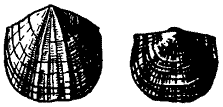


| Rhynchonelliformea | ||
| Brachiopoda | Strophomenata |
| Metazoa | |||
| Parent Cladogram | Invertebrates |

The Strophomenata are a wholly Paleozoic class; one of the two classes of advanced articulate brachiopods. They first appear in the middle Cambrian and continue through to the Late Permian. From the Devonian through to the Permian they are the most abundant of all brachiopods, adopting a large range of life-styles, including bivalve-like infaunal existence, and in another group, a coral-like growth habit. There are four orders, which are shown here:
 |
 |
 |
|
| Billingsellida | Orthotetida | Strophomenida | Productida |
Many strophomenates may be identified by their supra-apically located pedicle foramen, at least in young shells. Adult strophomenids and productids lacked an open pedicle foramen, and usually lived attached to the bottom or to other objects by the pedicle valve.
There is also a tendency among productids to cement their shells to the substrate. Strophomenids may have a scar on the umbo that was apparently the point of attachment for the juvenile stage, and some extreme productids even adopted a coral-like existence.